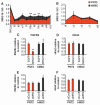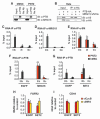Regulation of alternative splicing by histone modifications
- PMID: 20133523
- PMCID: PMC2913848
- DOI: 10.1126/science.1184208
Regulation of alternative splicing by histone modifications
Abstract
Alternative splicing of pre-mRNA is a prominent mechanism to generate protein diversity, yet its regulation is poorly understood. We demonstrated a direct role for histone modifications in alternative splicing. We found distinctive histone modification signatures that correlate with the splicing outcome in a set of human genes, and modulation of histone modifications causes splice site switching. Histone marks affect splicing outcome by influencing the recruitment of splicing regulators via a chromatin-binding protein. These results outline an adaptor system for the reading of histone marks by the pre-mRNA splicing machinery.
Figures





Comment in
-
Chromatin: the final frontier in splicing regulation?Dev Cell. 2010 Mar 16;18(3):336-8. doi: 10.1016/j.devcel.2010.03.002. Dev Cell. 2010. PMID: 20230741 Free PMC article.
-
Journal club. A human geneticist explores the ways that genes are regulated.Nature. 2010 Jul 1;466(7302):11. doi: 10.1038/466011e. Nature. 2010. PMID: 20595974 No abstract available.
Similar articles
-
Chromatin: the final frontier in splicing regulation?Dev Cell. 2010 Mar 16;18(3):336-8. doi: 10.1016/j.devcel.2010.03.002. Dev Cell. 2010. PMID: 20230741 Free PMC article.
-
A lncRNA regulates alternative splicing via establishment of a splicing-specific chromatin signature.Nat Struct Mol Biol. 2015 May;22(5):370-6. doi: 10.1038/nsmb.3005. Epub 2015 Apr 6. Nat Struct Mol Biol. 2015. PMID: 25849144 Free PMC article.
-
Histone marks regulate the epithelial-to-mesenchymal transition via alternative splicing.Cell Rep. 2022 Feb 15;38(7):110357. doi: 10.1016/j.celrep.2022.110357. Cell Rep. 2022. PMID: 35172149
-
Regulation of alternative splicing by local histone modifications: potential roles for RNA-guided mechanisms.Nucleic Acids Res. 2014 Jan;42(2):701-13. doi: 10.1093/nar/gkt875. Epub 2013 Sep 29. Nucleic Acids Res. 2014. PMID: 24081581 Free PMC article. Review.
-
Epigenetics in alternative pre-mRNA splicing.Cell. 2011 Jan 7;144(1):16-26. doi: 10.1016/j.cell.2010.11.056. Cell. 2011. PMID: 21215366 Free PMC article. Review.
Cited by
-
CD44 alternative splicing senses intragenic DNA methylation in tumors via direct and indirect mechanisms.Nucleic Acids Res. 2021 Jun 21;49(11):6213-6237. doi: 10.1093/nar/gkab437. Nucleic Acids Res. 2021. PMID: 34086943 Free PMC article.
-
Making alternative splicing decisions during epithelial-to-mesenchymal transition (EMT).Cell Mol Life Sci. 2012 Aug;69(15):2515-26. doi: 10.1007/s00018-012-0931-7. Epub 2012 Feb 19. Cell Mol Life Sci. 2012. PMID: 22349259 Free PMC article. Review.
-
Substitutions in the amino-terminal tail of neurospora histone H3 have varied effects on DNA methylation.PLoS Genet. 2011 Dec;7(12):e1002423. doi: 10.1371/journal.pgen.1002423. Epub 2011 Dec 29. PLoS Genet. 2011. PMID: 22242002 Free PMC article.
-
Loss of histone H4 lysine 20 trimethylation in osteosarcoma is associated with aberrant expression ofhistone methyltransferase SUV420H2.Oncol Lett. 2020 Oct;20(4):26. doi: 10.3892/ol.2020.11887. Epub 2020 Jul 16. Oncol Lett. 2020. PMID: 32774499 Free PMC article.
-
Mutation screen and RNA analysis disclose the changed splicing of the E-cadherin transcription in gastric cancer.Fam Cancer. 2013 Sep;12(3):547-54. doi: 10.1007/s10689-013-9619-x. Fam Cancer. 2013. PMID: 23435907
References
Publication types
MeSH terms
Substances
Associated data
- Actions
Grants and funding
LinkOut - more resources
Full Text Sources
Other Literature Sources
Molecular Biology Databases
Research Materials
Miscellaneous

